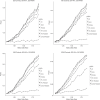Testing for risk and protective trends in genetic analyses of HIV acquisition
- PMID: 25270736
- PMCID: PMC4441099
- DOI: 10.1093/biostatistics/kxu044
Testing for risk and protective trends in genetic analyses of HIV acquisition
Abstract
Host genetics studies of HIV-1 acquisition are critically important for the identification of new targets for drug and vaccine development. Analyses of such studies typically focus on pairwise comparisons of three different groups: HIV-1 positive individuals, HIV-1 high-risk seronegative individuals, and population controls. Because there is a clear expectation of how gene frequencies of risk or protective alleles would be ordered in the three groups, we are able to construct a statistical framework that offers a consistent increase in power over a wide-range of the magnitude of risk/protective effects. In this paper, we develop tests that constrain the alternative hypothesis to appropriately reflect risk or protective trends jointly across the three groups and show that they lead to a substantial increase in power over the naive pairwise approach. We develop both likelihood-ratio and score statistics that test for genetic effects across the three groups while constraining the alternative hypothesis to reflect biologically motivated trends of risk or protection. The asymptotic distribution of both statistics (likelihood ratio and score) is derived. We investigate the performance of our approach via extensive simulation studies using a biologically motivated model of HIV-1 acquisition, and find that our proposed approach leads to an increase in power of roughly 10-28%. We illustrate our approach with an analysis of the effect of the CCR5Δ32 mutation on HIV acquisition.
Keywords: CCR5; Constrained alternative; HIV-1, Score statistic; High-risk seronegative.
© The Author 2014. Published by Oxford University Press. All rights reserved. For permissions, please e-mail: journals.permissions@oup.com.
Figures


References
-
- Bartholomew D. J. (1959). A test of homogeneity for ordered alternatives. Biometrika 46(1/2), 6–48.
-
- Carrington M., Dean M., Martin M. P., O’Brien S. J. (1999). Genetics of HIV-1 infection: chemokine receptor ccr5 polymorphism and its consequences. Human Molecular Genetics 8(10), 1939–1945. - PubMed
-
- Dean M., Carrington M., Winkler C., Huttley G. A., Smith M. W., Allikmets R., Goedert J. J., Buchbinder S. P., Vittinghoff E., Gomperts E., others (1996). Genetic restriction of HIV-1 infection and progression to aids by a deletion allele of the CKR5 structural gene. Hemophilia Growth and Development Study, Multicenter AIDS Cohort Study, Multicenter Hemophilia Cohort Study, San Francisco City Cohort, ALIVE Study. Science 273(5283), 1856–1862. - PubMed
Publication types
MeSH terms
Substances
Grants and funding
LinkOut - more resources
Full Text Sources
Other Literature Sources
Medical

